If used properly, functional resources and capabilities serve as strengths to carry out value-added activities and support strategic decision-making. If misused, these will then become weaknesses of the organization.
Functional resources and capabilities include not only the financial, physical, and human assets in each area of the organization, but also the ability of the people to formulate and implement necessary functional objectives, strategies, and policies.
These resources and capabilities include the knowledge of analytical concepts and procedural techniques common to each area as well as the ability of the people to implement them effectively and efficiently.
Strategic Marketing
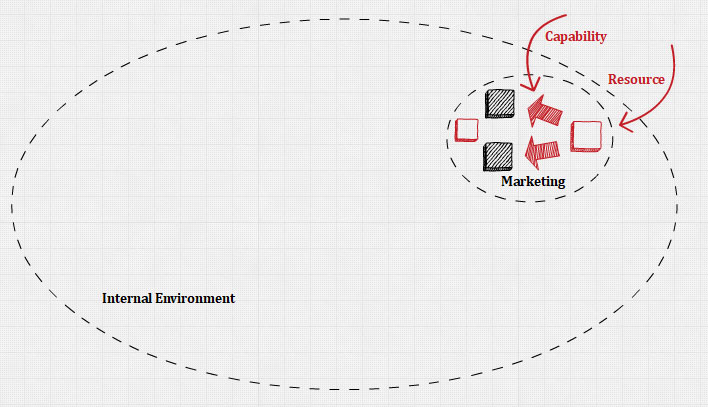
Marketing can be described as the process of defining, anticipating, creating, and fulfilling customers’ needs and wants for products and services.
Marketing is a company’s primary link to the customer and the competition. Therefore, this area of the company must concern with the market position and marketing mix of the firm, as well as with the overall reputation of the company and its brands.
There are 9 basic functions of marketing.
They are (1) customer analysis, (2) selling products/services, (3) product and service planning, (4) pricing, (5) distribution, (6) marketing research, and (7) cost/benefit analysis, and (8) marketing mix, and (9) brand and corporate reputation.
Understanding these functions helps management identify and evaluate marketing strengths and weaknesses.
Function 1: Customer Analysis
Customer analysis is the examination and evaluation of consumer needs, desires, and wants.
The information generated by customer analysis can be essential in developing an effective mission statement.
Through customer analysis, the organization can identify market segmentation with various products and services so that management can discover which niches to seek and which types of products to develop.
Customer analysis involves administering customer surveys, analyzing consumer information, evaluating market positioning strategies, developing customer profiles, and determining optimal market segmentation strategies.
Buyers, sellers, distributors, salespeople, managers, wholesalers, retailers, suppliers, and creditors can all participate in gathering information to successfully identify customers’ needs and wants.
Customer profiles can reveal the demographic characteristics of an organization’s customers.
Function 2: Products/Services Selling
Selling includes many marketing activities, such as advertising, sales promotion, publicity, personal selling, sales force management, customer relations, and dealer relations.
These activities are especially critical when a firm pursues a market penetration strategy.
The effectiveness of various activities for consumer and industrial products varies. Personal selling is most important for industrial goods companies, and advertising is most important for consumer goods companies.
Sales promotion consists of the communications used to market a product, including advertising, public relations, and other forms of direct and indirect selling.
Determining organizational strengths and weaknesses in the selling function of marketing is an important part of performing an internal environment scanning.
Function 3: Product and Service Planning
Product and service planning includes activities such as test marketing, product and brand positioning, devising warranties, packaging, determining product options, features, style, and quality, deleting old products, and providing customer service.
Product and service planning is particularly important when a company is pursuing product development or diversification.
One of the most effective products and service planning techniques is test marketing.
Test markets allow an organization to test alternative marketing plans and to forecast future sales of new products.
In conducting a test market project, an organization must decide how many cities to include, which cities to include, how long to run the test, what information to collect during the test, and what action to take after the test has been completed.
Test marketing is used more frequently by consumer goods companies than by industrial goods companies. Test marketing can allow an organization to avoid substantial losses by revealing weak products and ineffective marketing approaches before large-scale production begins.
Function 4: Pricing
Pricing decisions are generally affected by these 5 major stakeholder types: (1) consumers, (2) governments, (3) suppliers, (4) distributors, and (5) competitors.
Management should view price from both a short-run and a long-run perspective because competitors can copy price changes with relative ease. Often a dominant firm will aggressively match all price cuts by competitors.
Sometimes an organization will pursue a forward integration strategy primarily to gain better control over prices charged to consumers. Governments can impose constraints on price-fixing, price discrimination, minimum prices, unit pricing, price advertising, and price controls.
Function 5: Distribution
Some of the most complex and challenging decisions facing a firm concern product distribution. Distribution becomes especially important when a firm is striving to implement a market development or forward integration strategy.
Distribution includes warehousing, distribution channels, distribution coverage, retail site locations, sales territories, inventory levels and location, transportation carriers, wholesaling, and retailing.
Manufacturers who could afford to sell directly to the public often can gain great returns by expanding and improving their manufacturing operations. However, most producers today do not sell their goods directly to consumers.
There are various marketing entities that act as intermediaries. They bear a variety of names such as wholesalers, retailers, brokers, facilitators, agents, vendors, or distributors.
Possible approaches vary from direct selling to using just one or many wholesalers and retailers. The strengths and weaknesses of each channel alternative should be determined according to economic, control, and adaptive criteria.
Organizations should consider the costs and benefits of various wholesaling and retailing options. They must consider the need to motivate and control channel members and the need to adapt to changes in the future. Once a marketing channel is chosen, an organization usually must adhere to it for an extended period of time.
Function 6: Marketing Research
Marketing research is the systematic gathering, recording, and analyzing of data about problems relating to the marketing of goods and services.
Marketing research can uncover critical strengths and weaknesses, and marketing researchers employ numerous scales, instruments, procedures, concepts, and techniques to gather information.
Marketing research activities support all of the major business functions of an organization. Organizations that possess excellent marketing research skills have a definite strength in pursuing generic strategies.
Function 7: Cost/Benefit Analysis
Cost/benefit analysis involves assessing the costs, benefits, and risks associated with marketing decisions.
There are 3 steps that are required to perform a cost/benefit analysis.
They are: (1) compute the total costs associated with a decision, (2) estimate the total benefits from the decision, and (3) compare the total costs with the total benefits.
When expected benefits exceed total costs, an opportunity becomes more attractive.
Sometimes the variables included in a cost/benefit analysis cannot be quantified or even measured, but usually reasonable estimates can be made to allow the analysis to be performed.
Function 8: Marketing Mix
Marketing mix provides important insights into how to convince customers to purchase goods and services.
It refers to a particular combination of key variables under a corporation’s control that can be used to affect demand and to gain a competitive advantage. These variables are also known as the 4 P(s) of marketing: product, place, promotion, and price.
The real purpose of the marketing mix is to provide a strong alignment among the 4 P(s) that then offers customers a coherent and persuasive message.
Understanding the product life cycle enables management to examine the marketing mix of a particular product or group of products in terms of its position in its life cycle.
The product life cycle is a graph showing time plotted against monetary sales of a product as it moves from the introduction phase through growth, maturity, and decline.
Function 9: Brand and Corporate Reputation
A brand is a name given to a company product that identifies that item in the mind of the customer. A brand is an important resource of the organization.
A corporate brand is a type of brand in which the company name serves as the brand.
The corporate brand typically stands for customer impressions of the company and can be extended onto products. Thus, consumer impressions of a brand can suggest new product categories for the firm to enter even if it has not competitive advantage or competencies in making or marketing that type of product or service.
A corporate reputation is a widely held perception of a company by the general public.
A good corporate reputation can be a great strategic resource. It serves in marketing as both a signal and an entry barrier. Reputation is especially important when the quality of a company product or service is not directly observable and can be learned only through experience.
Strategic Finances
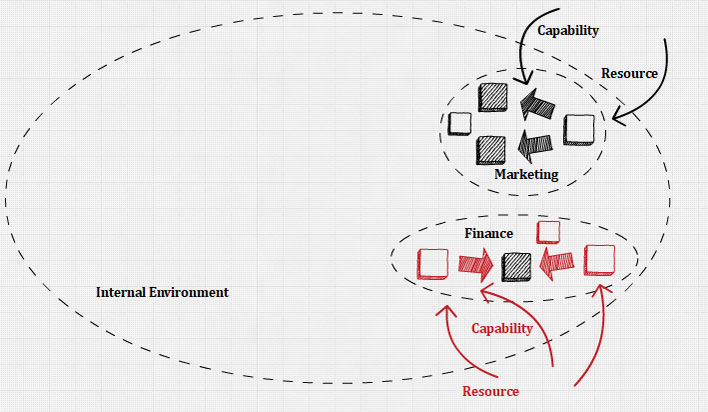
Determining an organization’s financial strengths and weaknesses is essential to effectively formulate strategies.
A firm’s liquidity, leverage, working capital, profitability, asset utilization, cash flow, and equity can eliminate some strategies as being feasible alternatives.
All strategic issues have financial implications. Financial condition is often considered the single best measure of a firm’s competitive position and overall attractiveness to investors. Financial factors often alter existing strategies and change implementation plans.
Financial management must ascertain the best sources of funds, uses of funds, and control of funds.
Cash must be raised from internal or external sources and allocated for different uses. The flow of funds in the operations must be monitored. Benefits in the form of returns, repayments, or products and services must be given to the sources of outside financing.
Finance & Accounting Functions
Financial ratio analysis is the most widely used method for determining an organization’s strengths and weaknesses in the investment, financing, and dividend areas.
Because the functional areas of business are so closely related, financial ratios can signal strengths or weaknesses in management, marketing, production, research and development, and management information systems activities.
The functions of finance and accounting comprise 3 decisions: (1) investment decision, (2) financing decision, and (3) dividend decision.
The investment decision, also called capital budgeting, is the allocation and reallocation of capital and resources to projects, products, assets, and divisions of an organization.
Once strategies are formulated, capital budgeting decisions are required to successfully implement strategies.
The financing decision determines the best capital structure for the firm and includes examining various methods by which the firm can raise capital.
The financing decision must consider both short-term and long-term needs for working capital. Two key financial ratios that indicate whether a firm’s financing decisions have been effective are the debt-to-equity ratio and the debt-to-total-assets ratio.
Dividend decisions concern issues such as the percentage of earnings paid to stockholders, the stability of dividends paid over time, and the repurchase or issuance of stock.
Dividend decisions determine the amount of funds that are retained in a firm compared to the amount paid out to stockholders. The benefits of paying dividends to investors must be balanced against the benefits of internally retaining funds, and there is no set formula on how to balance this trade-off.
Basic Types of Financial Ratios
Financial ratios are computed from an organization’s income statement and balance sheet.
Computing financial ratios is like taking a picture because the results reflect a situation at just one point in time. Comparing ratios over time and to industry averages is more likely to result in meaningful statistics that can be used to identify and evaluate strengths and weaknesses.
Financial ratio analysis must go beyond the actual calculation and interpretation of ratios. The analysis should be conducted on three separate fronts.
How has each ratio changed over time?
This information provides a means of evaluating historical trends. It is important to note whether each ratio has been historically increasing, decreasing, or nearly constant.
How does each ratio compare to industry norms?
A firm’s inventory turnover ratio may appear impressive at first glance but may pale when compared to industry standards or norms.
How does each ratio compare with key competitors?
Oftentimes competition is more intense between several competitors in a given industry or location than across all rival firms in the industry.
One of the limitations of financial ratios is that the conformity to industry composite ratios does not establish with certainty that a firm is performing normally or that it is well managed.
Financial ratios are based on accounting data, and firms differ in their treatment of such items as depreciation, inventory valuation, research and development expenditures, pension plan costs, mergers, and taxes.
It is important to recognize that a firm’s financial condition depends not only on the functions of finance but also on many other factors.
They are (1) management, marketing, management production/operations, research and development, and management information systems decisions; (2) actions by competitors, suppliers, distributors, creditors, customers, and shareholders; and (3) economic, social, cultural, demographic, environmental, political, governmental, legal, and technological trends.
Other Financial Concepts
Financial leverage is helpful in describing how debt is used to increase the earnings available to common shareholders. The debt, however, does raise the firm’s break-even point above what it would have been if the firm had financed from internally generated funds only. High leverage may be perceived as company strength in times of prosperity or weakness in times of recession.
Capital budgeting is the analyzing and ranking of possible investments in fixed assets such as land, buildings, or equipment. Preparing and ranking capital budgets on the basis of accepted criteria is important for strategic decision-making.
Strategic Research and Development
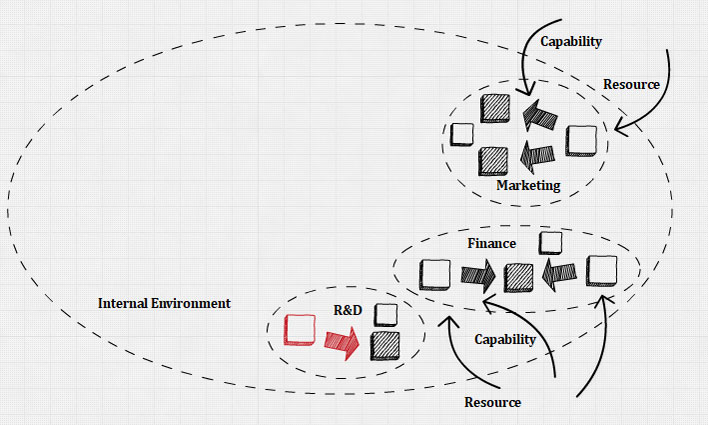
The research and development (R&D) function of the organization is responsible for suggesting and implementing technological strategy in light of its corporate objectives, strategies, and policies.
The R&D function of an organization should evaluate its technological capabilities in both the development and use of new technology.
A company should be proficient in technology transfer, which is the process of taking new technology from the laboratory to the marketplace. It should make a consistent research effort and research personnel management to ensure that the technology can be integrated into day-to-day operations.
A good rule of thumb for R&D spending is that a corporation should spend at a normal rate for that particular industry unless its strategic plan calls for unusual expenditures.
Expenditures of R&D are usually directed at developing new products before competitors do, at improving product quality, or at improving manufacturing processes to reduce costs.
The management of R&D would involve the following 3 tasks.
They are (1) choosing among alternative new technologies to use within the corporation, (2) developing methods of embodying the new technology in new products and processes, and (3) deploying resources so that the new technology can be successfully implemented.
To determine R&D budget allocations, commonly there are 4 approaches.
They are (1) financing as many project proposals as possible, (2) using a percentage-of-sales method, (3) budgeting about the same amount that competitors spend for R&D, or (4) deciding how many successful new products are needed and working backward to estimate the required R&D investment.
The concept of R&D exists because organizations making such an investment will have capabilities that greatly help in building core and distinctive competencies. These competencies will give these firms a competitive advantage.
The focus of R&D efforts can vary greatly depending on a firm’s competitive strategy.
Many firms today conduct no R&D, and yet many other companies depend on successful R&D activities for survival.
Some corporations attempt to be market leaders and innovators of new products, while others are satisfied to be market followers and developers of currently available products. Firms pursuing a product development strategy especially need to have a strong R&D orientation.
In cases where new product introduction is the driving force for strategy, R&D activities must be extensive. The R&D unit must then be able to advance scientific and technological knowledge, exploit that knowledge, and manage the risks associated with ideas, products, services, and production requirements.
Most firms have no choice but to continually develop new and improved products because of changing consumer needs and tastes, new technologies, shortened product life cycles, and increased domestic and foreign competition.
A shortage of ideas for new products, increased global competition, increased market segmentation, strong special interest groups, and increased government regulations are several factors making the successful development of new products more and more difficult, costly, and risky.
Internal vs. Contract R&D
R&D in organizations can take 2 basic forms.
They are (1) internal R&D, in which an organization operates its own R&D department, and/or (2) contract R&D, in which a firm hires independent researchers or independent agencies to develop specific products.
Basic, Product, and Process R&D
The R&D function of a firm consists of a mix between basic, product, and process R&D.
The balance of these 3 types within a firm is known as the R&D mix. Most corporations have these 3 types mixed depending on their industries and product lines.
Basic R&D is conducted with a focus on theoretical problem areas. A company will have this capability if it has patents and research publications.
Product R&D is concerned with marketing, product, and product packaging improvements. The company has a good capability of product R&D if it has a number of successful products introduced.
Process R&D is concerned with engineering, concentrating on quality control, and the development of design specifications and production equipment. A good capability of process R&D can be measured by consistent reductions in unit manufacturing costs, and a number of product defects.
With regard to stages of the product life cycle, product R&D usually dominates in the early stages, while process R&D becomes important in the later stages.
Technological Discontinuity
Technological discontinuity is when a new technology cannot be used to enhance the current technology but can only replace it.
This concept exists because every technology has a limit so that the past development of any given technology cannot be extrapolated infinitely into the future. Thus, incremental processes can occur depending on the specific technology, but only to a certain extent.
Firms must be aware of technological discontinuity because this is one of the keys to develop and maintain their technology capabilities.
To implement this concept successfully, firms must determine when to best abandon the current technology and shift resources to develop or adopt technology that has more potential.
Doing that is challenging because organizations are usually reluctant to switch their technologies. It is because new technology is generally riskier and of little appeal to current customers, while products derived from new technology are also more expensive.
However, if firms wait for technology to be well-developed and cost to be reasonable, it then maybe too late to switch. If this happens, firms may lose their competitive position in the industry. They may be able to remain in the industry with reduced market share until they can utilize new technologies capabilities and regain their competitive advantage.
Management of R&D
Management of R&D can be an important capability for a firm.
To implement effective management of R&D function, firms need to build a strategic and operational partnership between R&D and other vital business functions.
The overall mission of R&D is expanded, including supporting existing businesses, helping launch new businesses, developing new products, improving product quality, improving manufacturing efficiency, and deepening or broadening the company’s technological capabilities.
R&D decisions and plans must be integrated and coordinated across departments and divisions by having the departments share experiences and information.
Modern firms seek to organize R&D activities in a way that breaks the isolation of R&D from the rest of the company and promotes a spirit of partnership between R&D managers and other managers in the firm.
The related managers can jointly explore, assess, and decide what, when, where, why, and how much to R&D. Priorities, costs, benefits, risks, and rewards associated with R&D activities are openly discussed and shared.
Strategic Production/Operations
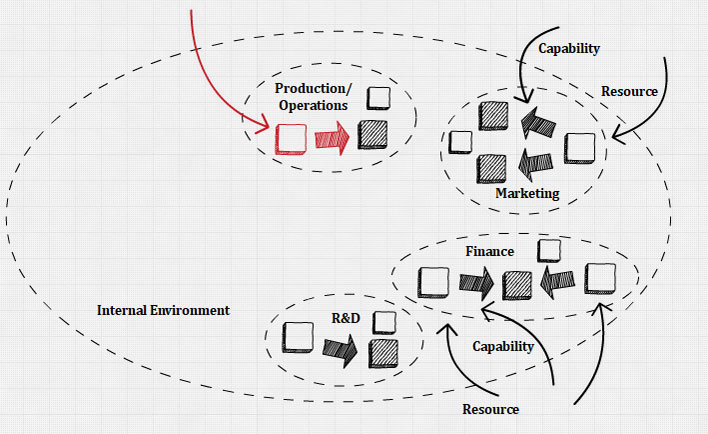
The production/operations function of a business consists of all those activities that transform inputs into goods and services.
It deals with inputs, transformations, and outputs that vary across industries and markets. Inputs such as raw materials, labor, capital, machines, and facilities are converted into finished goods and services, with a certain quality, at a given cost, within a given time frame.
Production/operations activities often represent the largest part of an organization’s human and capital assets.
In most industries, the major costs of producing a product or service are incurred within operations, so production/operations can have great value as a competitive weapon in a company’s overall strategy.
Many of the key concepts and techniques used in manufacturing can be applied to service businesses.
Production/Operations Functions
Production/operations management comprises 5 functions or decision areas: process, capacity, inventory, workforce, and quality.
Strengths and weaknesses in the 5 functions of production/operations can mean the success or failure of an enterprise.
Process: These functions include choices of technology, facility layout, process flow analysis, facility location, line balancing, process control, and transportation analysis. Distances from raw materials to production sites to customers are a major consideration.
Capacity: These functions include forecasting, facilities planning, aggregate planning, scheduling, capacity planning, and queuing analysis. Capacity utilization is a major consideration.
Inventory: These functions involve managing the level of raw materials, work-in-process, and finished goods, especially considering what to order, when to order, how much to order, and materials handling.
Workforce: These functions involve managing the skilled, unskilled, clerical, and managerial employees by caring for job design, work measurement, job enrichment, work standards, and motivation techniques.
Quality: These functions are aimed at ensuring that high-quality goods and services are produced by caring for quality control, sampling, testing, quality assurance, and cost control.
Intermittent vs. Continuous System
An intermittent system is a system where an item is normally processed sequentially, but the sequence of the process may vary.
Therefore, it usually has a low fixed cost and high variable cost. This characteristic allows the firm to be operating at low levels and still be profitable.
A continuous system is a system where an item is processed automatically, with a fixed process.
Firms invest heavily in fixed investments such as automated processes or complicated machinery.
Therefore, firms in this category have a high break-even point and low variable cost line. The advantage of these firms is when the company reaches the break-even point, its profits raise faster than those that use the intermittent system.
Experience Curve
The experience curve suggests that unit production costs decline by some fixed percentage each time the total accumulated volume of production doubles.
The actual percentage varies by industry and is based on many variables: the amount of time for employees to learn new skills, scale economies, product and process improvements, and others.
Achieving this result usually means investing in R&D and fixed assets. The strategy should be to build capacity ahead of demand to achieve lower unit costs. At some point during the experience curve, the organization should price the product and service very low to increase market demand.
Although many companies have used experience curves, having an unquestioning acceptance of the industry norm is very risky. The experience curve of the industry also may not hold true for a particular company due to various reasons.
Flexible Manufacturing for Mass Customization
Flexible manufacturing permits low-volume output of customized products at relatively low unit costs through economies of scope.
Economies of scope are about having common parts of the manufacturing activities of various products combined to gain economies even though small numbers of each product are made.
The use of robots and technology also gives rise to the idea that products can be economically manufactured in customized batches in a process called mass customization. Thus, it would be possible to have a cost advantage in flexible manufacturing for mass customization.
Strategic Human Resource
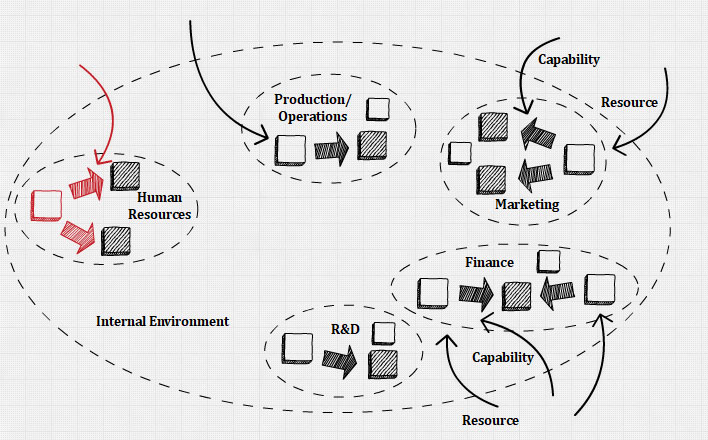
Human resources may be a key to achieving sustainable competitive advantage.
Human resources may be classified as a strength of the organization if it can utilize its employees with great flexibility.
One of the benefits of human resource management is to improve the match between individuals and jobs.
Another benefit of human resources is to facilitate the commitment of employees to the company, which in turn increases the likelihood for successful implementation of strategies.
Companies with good human resource management practices generally have higher profits and better survival rates than do firms without these practices.
Job Analysis
Job analysis is about obtaining job description information about what each job in the organization needs to accomplish in terms of quality and quantity.
This description information is not only essential for proper employee selection, development, and appraisal but also critical in obtaining the overview of corporate-wide human resources.
Without proper employee selection, employees would not have the skills to carry out the required tasks. Without a proper job description, jobs cannot be designed to accommodate the available workforce. If any of those happens, the implementation of any strategies would not be able to proceed.
Organizing Teams
There are several ways human resources can organize teams and make good use of them.
An autonomous work team is a group of people that work together without a supervisor to plan, coordinate, and evaluate their own work.
A cross-functional work team is a group of people that come from separate departments.
Instead of developing a product in a series of steps, beginning with requests from sales, which leads to design, then engineering and so on, companies using this type of work team can bring the people from different departments closer together and get them to involve early on in projects.
Concurrent engineering is a process in which specialists work side by side to compare notes constantly in an effort to design cost-effective products with features that customers actually want.
However, for such groups to work effectively, they must receive a lot of training and coaching. Otherwise, poorly implemented teams may worsen morale and create divisiveness.
A virtual team is a group of people that are geographically or organizationally dispersed and are assembled using a combination of telecommunications and information technologies to accomplish an organizational task.
Membership of these teams is often fluid, depending upon the task to be accomplished. They may include not only employees from different functions within a company but also members of various stakeholder groups, such as suppliers and customers.
Quality of Work Life
Quality of work life is about reducing employee dissatisfaction and unionization efforts.
Traditionally companies have focused on technical and economic factors in job design. Modern organizations need to emphasize more in improving the human dimension of work. These improvements will lead to a much more participative corporate culture and higher productivity and quality products.
Human Diversity
Human diversity refers to the mix in the workplace of people from different races, cultures, and backgrounds.
Generally, an increase in racial diversity will lead to an increase in firm performance. Management must work toward ensuring that people are treated fairly on the job and not harassed by prejudiced co-workers or managers.
Strategic Information Systems and Technology
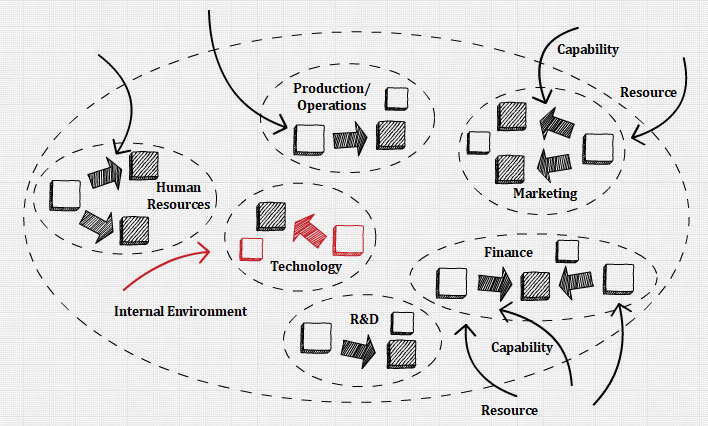
Information is the cornerstone of all organizations, that ties all business functions together and provides the basis for all managerial decisions.
The information represents a major source of competitive management advantage or disadvantage. Assessing a firm’s internal strengths and weaknesses in information systems is a critical dimension of performing an internal environment scanning.
Information Systems
A management information system’s purpose is to improve the performance of an enterprise by improving the quality of managerial decisions.
Firms whose information system skills are weak are at a competitive disadvantage. In contrast, strengths in information systems allow firms to establish distinctive competencies in other areas.
Information systems are a major strategic resource, monitoring internal and external issues and trends, identifying competitive threats and assisting in the implementation, evaluation, and control of strategy.
Management in information systems and technology should focus on designing and managing the flow of information in the organization in a way that improves productivity and decision making. The information must be collected, stored, and synthesized in a manner that can answer important operating and strategic questions.
An effective information system collects, codes, stores, synthesizes and presents information in such a manner that it answers important operating and strategic questions throughout the organization.
The heart of an information system is a database containing the kinds of records and data important to managers.
There is a logical flow of material in a computer information system, whereby data are input to the system and transformed into output.
A management information system receives raw material from both the external and internal evaluation of an organization. It gathers data about marketing, finance, production, and personnel matters internally, and social, cultural, demographic, environmental, economic, political, governmental, legal, technological, and competitive factors externally.
Outputs include computer printouts, written reports, tables, charts, graphs, checks, purchase orders, invoices, inventory records, payroll accounts, and a variety of other documents. Payoffs from alternative strategies can be calculated and estimated.
Data are then integrated into ways needed to support managerial decision-making.
Data become information only when they are evaluated, filtered, condensed, analyzed, and organized for a specific purpose, problem, individual, or time.
Because organizations are becoming more complex, decentralized, and globally dispersed, the function of information systems is growing in importance.
Spurring this advance is the falling cost and increasing power of computers. There are costs and benefits associated with obtaining and evaluating information, just as with equipment and land. Like equipment, information can become obsolete and may need to be purged from the system.
Corporate Performance Impact
Information systems and technology offer 4 main contributions to corporate performance.
The first contribution is that it is used to automate existing back-office processes, such as payroll, human resource records, accounts payable and receivable, and to establish databases.
The second contribution is that it is used to automate individual tasks and reduce costs, such as keeping track of clients and expenses. Corporate databases are accessed to provide sufficient data to analyze the information and create what-if scenarios.
The third contribution is that it is used to enhance key business functions, such as marketing and operations. The systems provide customer support and help in distribution and logistics. Business processes are analyzed to increase efficiency and productivity via reengineering. This contribution focuses more on productivity improvement.
The fourth contribution is that it is used to develop a competitive advantage. Thus, information systems and their technology are playing a strategic part in moving an organization forward, instead of just cutting costs and improve efficiency.
Supply Chain Impact
Supply chain management is the forming of networks for sourcing raw materials, manufacturing products or creating services, storing and distributing the goods, and delivering them to customers and consumers.
Supply chains are important in reducing cost, improving customer services, and getting new products to market faster.
It is becoming more and more important to integrate modern technology and systems into corporate supply chains to harmonize companywide efforts and to achieve competitive advantage.
Resources
Further Reading
- Unboxing Marketing Capabilities (themarketingcapabilityacademy.com)
- Everything You Need to Know About Marketing Resource Management (filestage.io)
- Marketing resources and capabilities for growth (equinetmedia.com)
- The Effects of Human Resource Capability and Internal Customer Satisfaction on Organizational Effectiveness (journals.sagepub.com)
- Resources and Capabilities Analysis: The Human Resource Perspective (saviom.com)
- IT Capabilities (cio-wiki.org)
- Even if IT Doesn’t Matter, Informational Capabilities Still Do (csoonline.com)
Related Concepts
References
- Hitt, M. A., Ireland, D. R., & Hoskisson, R. E. (2016). Strategic Management: Concepts: Competitiveness and Globalization (12th ed.). Cengage Learning.
- Hitt, M. A., Ireland, D. R., & Hoskisson, R. E. (2019). Strategic Management: Concepts and Cases: Competitiveness and Globalization (MindTap Course List) (13th ed.). Cengage Learning.
- Wheelen, T. L. (2021). Strategic Management and Business Policy: Toward Global Sustainability 13th (thirteenth) edition Text Only. Prentice Hall.